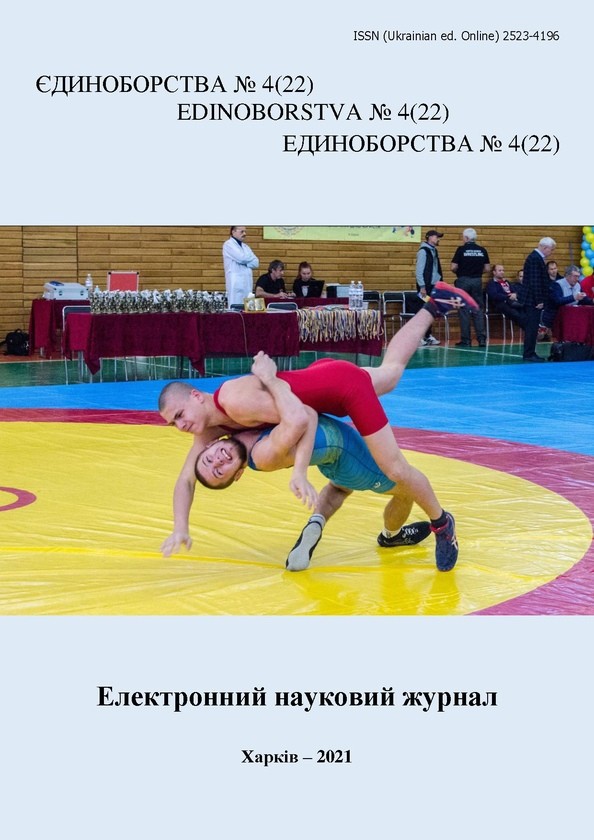Dynamics of special physical training of qualified MMA fighters during the preparatory period of the macrocycle when performing shock equipment
DOI:
https://doi.org/10.15391/ed.2021-4.04Keywords:
mixed martial arts, qualified fighters, special physical training, interval training method, Interval-circular training method, training aidsAbstract
Purpose: to determine the influence of the experimental training program for qualified mixed
martial arts fighters of 18-19 years old on their special physical fitness when performing shock
actions. Material and methods. The study involved seven athletes 18-19 years old (all athletes -
KMSU) department of mixed martial arts ODYUSSH «Dinamovets» in Zhitomir. A training
program for qualified junior mixed martial arts fighters was developed using interval and interval-circular training methods with a wide range of general, special and competitive training means.
The training program is designed for 15 weeks (may 17 - august 27, 2021) in the preparatory
period of the macrocycle, therefore its predominant focus was towards physical fitness. Research
methods: analysis of scientific theoretical sources, conversations with specialists, pedagogical
observations, pedagogical testing, methods of mathematical statistics. Results: the dynamics of
special physical readiness of qualified fighters was investigated, under the influence of an
experimental training program, when performing percussion technique. The study of the dynamics
of special physical readiness when performing a series of punches with hands showed significant
positive shifts in the total force of punches with hands during the execution of an 8-second series
(t=3,02; p˂0.05) and a 40-second series of punches (t=7,69; p˂0,001). The result of the average
force of strikes (t=2,21; p˂0,05) in a 40-second series of strikes also noticeably improved. The
study of the dynamics of special physical readiness when performing a series of strikes with the
dominant leg revealed positive changes in the total force of strikes in the 8-second (t=3,33; p˂0,01)
and 40-second (t=5,39; p˂0,001) tests. The high-speed component of the striking technique did not
undergo significant positive changes, although there is a tendency towards positive dynamics
(p>0,05). Conclusions. It was determined that the introduction of an experimental training
program into the educational and training process of 18-19 year old mixed martial arts fighters
made it possible to improve the special physical fitness of the fighters when performing specific
striking techniques. In five studied indicators, a significant positive trend was obtained, confirmed
by mathematical calculations. Significant positive changes in the total strength in the series of
punches with the hands and the dominant leg were determined both in the 8-second and in the 40-
second tests (p˂0,05 - p˂0,001). We also found a significant positive dynamics in the average force
of punches in the 40-second test (p˂0,05).
References
Ананченко, К.В., Бойченко, Н.В., & Ручка, Є.В. (2019). Вдосконалення техніко-тактичної майстерності рукопашників. Єдиноборства, №2, 12-19.
Гуцул, Н.З. (2019). Удосконалення спеціальної фізичної підготовки кікбоксерів з урахуванням різних стилів змагальної діяльності на етапі спеціалізованої базової підготовки. (Дис. … канд. наук з фіз.вих.). Львів, Україна.
Затірка, В.В., & Камаєв, О.І. (2019). Особливості спеціальної фізичної підготовки кваліфікованих спортсменів у змішаних єдиноборствах. Основи побудови тренувального процесу в циклічних та екстремальних видах спорту., В 3, 168-171.
Катихін, В.М., Тропін, Ю.М., & Латишев, М.В. (2021). Профілі сильніших бійців змішаних єдиноборств ММА. Єдиноборства, № 1(19), 20-32.
Катихін, В.М., Тропін, Ю.М., & Шенпен Го (2020). Динаміка фізичної підготовленості кваліфікованих бійців змішаних єдиноборств ММА в групах спеціалізованої підготовки. Єдиноборства, № 3(17), 25-35.
Кладов, Э.В., & Шульпина, В.П. (2014). Контроль общей и специальной физической подготовленности кикбоксеров учебно-тренировочных групп. Современные проблемы науки и образования, № 6, 939.
Огарь. Г.О., & Мартиненко, Є.М. (2020). Динаміка показників силової підготовленості та спеціальної витривалості самбістів 16-17 років під впливом статодинамічного та інтервально-колового методів тренування. Єдиноборства, №4(18), 35-43.
Платонов, В.Н. (2004). Система подготовки спортсменов в олимпийском спорте. Олимпийская литература, Киев.
Савчин, М.П. (2003). Тренованість боксера та її діагностика. Нора-прінт, Київ.
Тарасова, Г.К., & Музичук, О.В. (2019). Характеристика фізичних якостей спортсмена у змішаних єдиноборствах. Теорія та практика сучасної науки та освіти. Матеріали Міжнародної наукової конференції, м. Дніпро, Частина ІІ., 292-293.
Хацаюк, О.В., Ананчанко, К.В., Хуртенко, О.В., Дмитренко, С.М., & Бойченко, Н.В. (2020). Дослідження технічного арсеналу бійців ММА високої кваліфікації. Єдиноборства,№3(17), 92-105.
Beranek, V., Stastny, P., Novacek, V., Votapek. P., & Formanek, J. (2020). Upper limb strikes reactive forces in mix martial art athletes during ground and pound tactics. Int J Environ Res Public Health, 17(21).
Halperin, I., Chapman, D.W., Martin. D.T., & Abbiss, C.R. (2017). The effects of attentional focus instructions on punching velocity and impact forces among trained combat athletes. J. Sports Sci. 35, 500–507.
James, L.P., Haff, G., Gregory, Kelly Vincent, G., & Beckman, Emma M. (2016). Towards a determination of the physiological characteristics distinguishing successful mixed martial arts athletes: a systematic review of combat sport literature. Sports Medicine. 46, 1525–1551.
Kirk, C. (2018). Does anthropometry influence technical factors in competitive mixed martial arts? Human Movement. 19, 46–59.
Kirk, C., Langan-Evans, C., & Clark, D.R., Morton, J.P. (2021). Quantification of training load distribution in mixed martial arts athletes: a lack of periodisation and load management. PLoS One, 16(5).
Kostikiadis, I.N., Methenitis, S., Tsoukos, A., Veligekas. P., Terzis, G., & Bogdanis, G.C. (2018). The effect of short-term sport-specific strength and conditioning training on physical fitness of well-trained mixed martial arts athletes. Journal of Sports Science and Medicine. 17(3): 348–58.
Mikeska, J. Daniel (2014). A 12-week metabolic conditioning program for a mixed martial artist. Strength and Conditioning Journal, 36(5), 61-67.
Petersen, C., & Lindsay, A. (2020). Movement and physiological demands of amateur mixed martial art fighting. The Journal of Sport and Exercise Science. 4(1), 40-43.
Pinto, F., Neiva, H., Nunes, C., Marques, M., Sousa, C., Marinho, D., Branquinho, L., & Ferraz, R.(2020). Ultimate full contact: fight outcome characterization concerning their methods, occurrence times and technical–tactical developments. International Journal of Environmental Research and Public Health, 17(19),
Spanias P., Nikolaidis, T., Rosemann, T., & Knechtle B. (2019). Anthropometric and physiological profile of mixed martial art athletes: A Brief Review. Sports, 7, 146-152.













